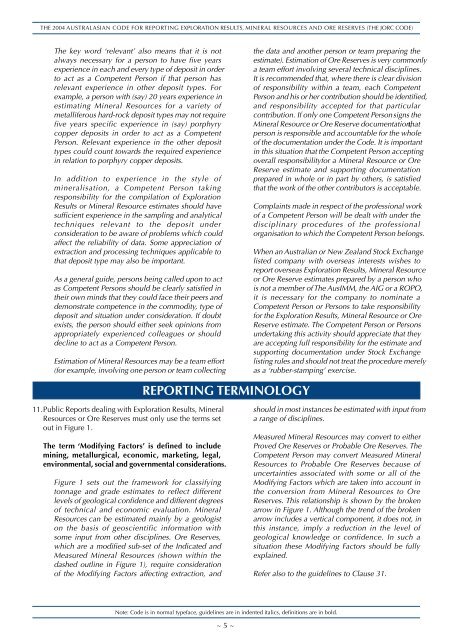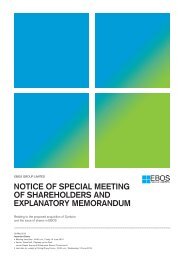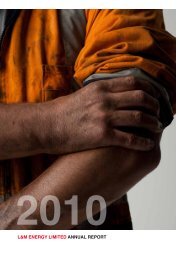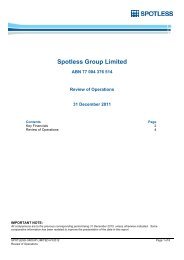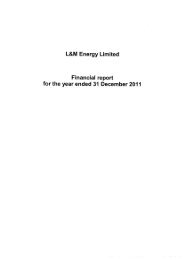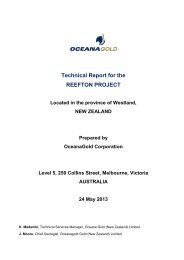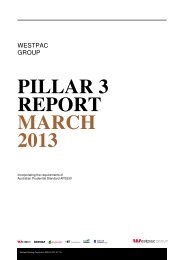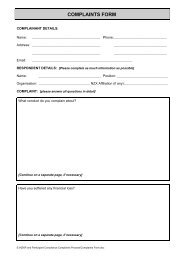NZSX/ NZDX Listing Rules APPENDIX 1 Part A (Rules 10.4.2 ... - NZX
NZSX/ NZDX Listing Rules APPENDIX 1 Part A (Rules 10.4.2 ... - NZX
NZSX/ NZDX Listing Rules APPENDIX 1 Part A (Rules 10.4.2 ... - NZX
Create successful ePaper yourself
Turn your PDF publications into a flip-book with our unique Google optimized e-Paper software.
THE 2004 AUSTRALASIAN CODE FOR REPORTING EXPLORATION RESULTS, MINERAL RESOURCES AND ORE RESERVES (THE JORC CODE)<br />
The key word ‘relevant’ also means that it is not<br />
always necessary for a person to have five years<br />
experience in each and every type of deposit in order<br />
to act as a Competent Person if that person has<br />
relevant experience in other deposit types. For<br />
example, a person with (say) 20 years experience in<br />
estimating Mineral Resources for a variety of<br />
metalliferous hard-rock deposit types may not require<br />
five years specific experience in (say) porphyry<br />
copper deposits in order to act as a Competent<br />
Person. Relevant experience in the other deposit<br />
types could count towards the required experience<br />
in relation to porphyry copper deposits.<br />
In addition to experience in the style of<br />
mineralisation, a Competent Person taking<br />
responsibility for the compilation of Exploration<br />
Results or Mineral Resource estimates should have<br />
sufficient experience in the sampling and analytical<br />
techniques relevant to the deposit under<br />
consideration to be aware of problems which could<br />
affect the reliability of data. Some appreciation of<br />
extraction and processing techniques applicable to<br />
that deposit type may also be important.<br />
As a general guide, persons being called upon to act<br />
as Competent Persons should be clearly satisfied in<br />
their own minds that they could face their peers and<br />
demonstrate competence in the commodity, type of<br />
deposit and situation under consideration. If doubt<br />
exists, the person should either seek opinions from<br />
appropriately experienced colleagues or should<br />
decline to act as a Competent Person.<br />
Estimation of Mineral Resources may be a team effort<br />
(for example, involving one person or team collecting<br />
REPORTING TERMINOLOGY<br />
the data and another person or team preparing the<br />
estimate). Estimation of Ore Reserves is very commonly<br />
a team effort involving several technical disciplines.<br />
It is recommended that, where there is clear division<br />
of responsibility within a team, each Competent<br />
Person and his or her contribution should be identified,<br />
and responsibility accepted for that particular<br />
contribution. If only one Competent Person signs the<br />
Mineral Resource or Ore Reserve documentation, that<br />
person is responsible and accountable for the whole<br />
of the documentation under the Code. It is important<br />
in this situation that the Competent Person accepting<br />
overall responsibility for a Mineral Resource or Ore<br />
Reserve estimate and supporting documentation<br />
prepared in whole or in part by others, is satisfied<br />
that the work of the other contributors is acceptable.<br />
Complaints made in respect of the professional work<br />
of a Competent Person will be dealt with under the<br />
disciplinary procedures of the professional<br />
organisation to which the Competent Person belongs.<br />
When an Australian or New Zealand Stock Exchange<br />
listed company with overseas interests wishes to<br />
report overseas Exploration Results, Mineral Resource<br />
or Ore Reserve estimates prepared by a person who<br />
is not a member of The AusIMM, the AIG or a ROPO,<br />
it is necessary for the company to nominate a<br />
Competent Person or Persons to take responsibility<br />
for the Exploration Results, Mineral Resource or Ore<br />
Reserve estimate. The Competent Person or Persons<br />
undertaking this activity should appreciate that they<br />
are accepting full responsibility for the estimate and<br />
supporting documentation under Stock Exchange<br />
listing rules and should not treat the procedure merely<br />
as a ‘rubber-stamping’ exercise.<br />
11.Public Reports dealing with Exploration Results, Mineral<br />
Resources or Ore Reserves must only use the terms set<br />
out in Figure 1.<br />
The term ‘Modifying Factors’ is defined to include<br />
mining, metallurgical, economic, marketing, legal,<br />
environmental, social and governmental considerations.<br />
Figure 1 sets out the framework for classifying<br />
tonnage and grade estimates to reflect different<br />
levels of geological confidence and different degrees<br />
of technical and economic evaluation. Mineral<br />
Resources can be estimated mainly by a geologist<br />
on the basis of geoscientific information with<br />
some input from other disciplines. Ore Reserves,<br />
which are a modified sub-set of the Indicated and<br />
Measured Mineral Resources (shown within the<br />
dashed outline in Figure 1), require consideration<br />
of the Modifying Factors affecting extraction, and<br />
should in most instances be estimated with input from<br />
a range of disciplines.<br />
Measured Mineral Resources may convert to either<br />
Proved Ore Reserves or Probable Ore Reserves. The<br />
Competent Person may convert Measured Mineral<br />
Resources to Probable Ore Reserves because of<br />
uncertainties associated with some or all of the<br />
Modifying Factors which are taken into account in<br />
the conversion from Mineral Resources to Ore<br />
Reserves. This relationship is shown by the broken<br />
arrow in Figure 1. Although the trend of the broken<br />
arrow includes a vertical component, it does not, in<br />
this instance, imply a reduction in the level of<br />
geological knowledge or confidence. In such a<br />
situation these Modifying Factors should be fully<br />
explained.<br />
Refer also to the guidelines to Clause 31.<br />
Note: Code is in normal typeface, guidelines are in indented italics, definitions are in bold.<br />
~ 5 ~


